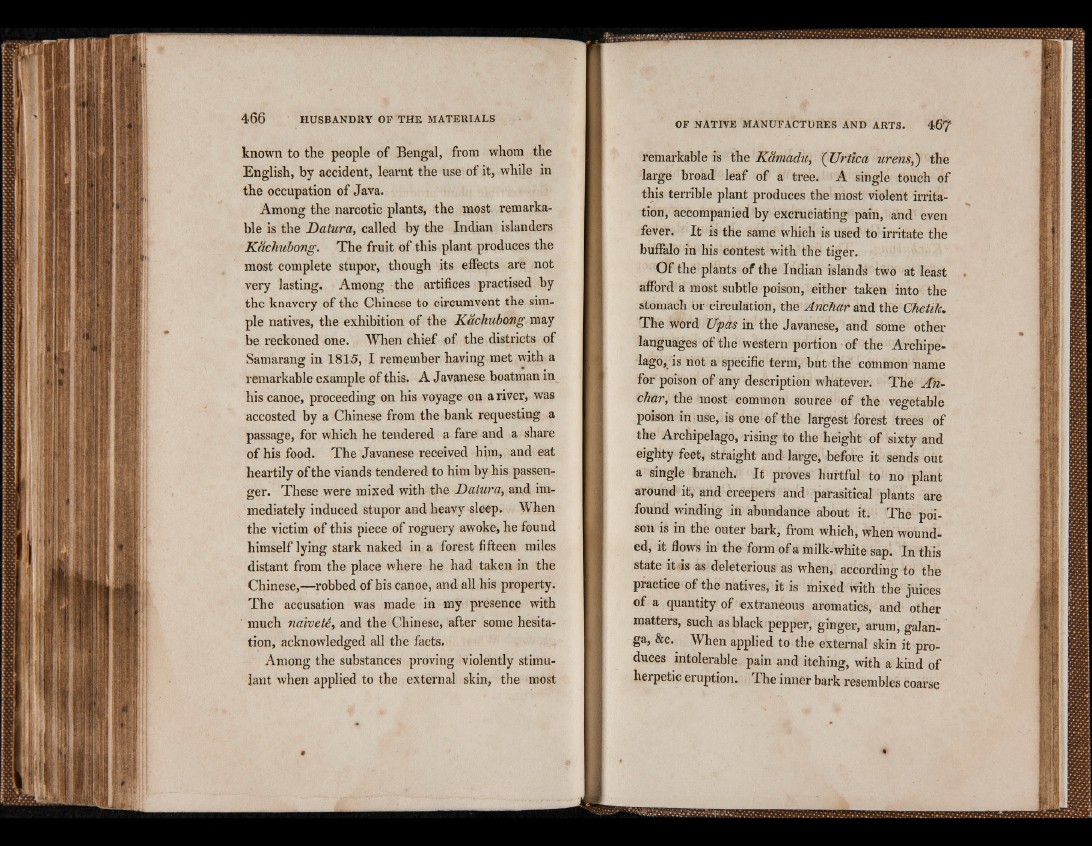
known to the people of Bengal, from whom the
English, by accident, learnt the use of it, while in
the occupation of Java.
Among the narcotic plants, the most remarkable
is the Datura, called by the Indian islanders
Kachubong. The fruit of this plant produces the
most complete stupor, though its effects are not
very lasting. Among the artifices practised by
the knavery of the Chinese to circumvent the simple
natives, the exhibition of the Kachubong may
be reckoned one. When chief of the districts of
Samarang in 1815, I remember having met with a
remarkable example of this. A Javanese boatman in
his canoe, proceeding on his voyage on a river, was
accosted by a Chinese from the bank requesting a
passage, for which he tendered a fare and a share
of his food. The Javanese received him, and eat
heartily of the viands tendered to him by his passenger.
These were mixed with the Datura, and immediately
induced stupor and heavy sleep. When
the victim of this piece of roguery awoke, he found
himself lying stark naked in a forest fifteen miles
distant from the place where he had taken in the
Chinese,—robbed of his canoe, and all his property.
The accusation was made in my presence with
much naivete, and the Chinese, after some hesitation,
acknowledged all the facts.
Among the substances proving violently stimulant
when applied to the external skin, the most
remarkable is the Kamadu, ( TJrtica urens,) the
large broad leaf of a tree. A single touch of
this terrible plant produces the most violent irritation,
accompanied by excruciating pain, and even
fever. It is the same which is used to irritate the
buffalo in his contest with the tioger.
Of the plants of the Indian islands two at least
afford a most subtle poison, either taken into the
stomach or circulation, the Anchar and the ChetiJc,
The word Upas in the Javanese, and some other
languages of the western portion of the Archipelago,
is not a specific term, but the common name
for poison of any description whatever. The Anchar,
the most common source of the vegetable
poison in use,, is one of the largest forest trees of
the Archipelago, rising to the height of sixty and
eighty feet, straight and large, before it sends out
a single branch. It proves hurtful to no plant
around it, and creepers and parasitical plants are
found winding in abundance about it. The poison
is in the outer bark, from which, when wounded,
it flows in the form of a milk-white sap. In this
state it ds as deleterious as when, according to the
practice of the natives, it is mixed with the juices
of a quantity of extraneous aromatics, and other
matters, such as black pepper, ginger, arum, galan-
ga, &c. When applied to the external skin it produces
intolerable pain and itching, with a kind of
herpetic eruption. The inner bark resembles coarse